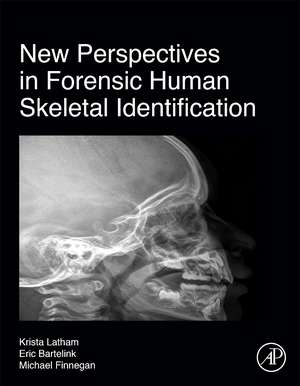New Perspectives in Forensic Human Skeletal Identification
Editat de Krista E. Latham, Eric J. Bartelink, Michael Finneganen Limba Engleză Hardback – 28 iul 2017
The contributing authors represent established experts in forensic anthropology and closely related fields. New Perspectives in Forensic Human Skeletal Identification will be an essential resource for researchers, practitioners, and advanced students interested in state-of-the-art methods for human identification.
- A comprehensive and up-to-date volume on human identification methods in forensic anthropology
- Focuses on recent advances such as statistical and morphometric methods for assessing the biological profile, biochemical methods of identification and use of comparative radiography
- Includes an entire section on human identification techniques being applied to international populations and disaster victims
Preț: 438.10 lei
Preț vechi: 577.75 lei
-24% Nou
Puncte Express: 657
Preț estimativ în valută:
83.83€ • 86.48$ • 69.96£
83.83€ • 86.48$ • 69.96£
Carte tipărită la comandă
Livrare economică 19 martie-02 aprilie
Preluare comenzi: 021 569.72.76
Specificații
ISBN-13: 9780128054291
ISBN-10: 0128054298
Pagini: 374
Dimensiuni: 216 x 276 x 26 mm
Editura: ELSEVIER SCIENCE
ISBN-10: 0128054298
Pagini: 374
Dimensiuni: 216 x 276 x 26 mm
Editura: ELSEVIER SCIENCE
Cuprins
1. Introduction
Section I: Advances in Biological Profile Construction
2. Human Variability and Forensic Anthropology
3. Advances in Morphometrics for Sex and Ancestry Assessment
4. Advances in cranial macromorphoscopic trait and dental morphology analysis for ancestry estimation
5. hu(MAN)id: an R-based Application and GUI Utilizing Linear Discriminant Analysis for Classifying the Human Mandible
6. A Decade of Development in Juvenile Aging
7. Estimation of Immature Age from the Dentition
8. Adult Age-at-death Estimation in Unknown Decedents: New Perspectives on an Old Problem
9. Multivariate regression methods for the analysis of stature
10. Full Skeleton Stature Estimation
11. The History and Use of NamUs
Section II: Advances in Molecular and Microscopic Methods of Identification
12. The Utilization of Databases for the Identification of Human Remains
13. Flexibility in Testing Skeletonized Remains for DNA Analysis Can Lead to Increased Success: Suggestions and Case Studies
14. Forensic identification of human skeletal remains using isotopes: A brief history of applications from archaeological dig sites to modern crime scenes
15. Stable Isotopes Analysis: Case Applications
16. Bomb Pulse Radiocarbon Dating of Skeletal Tissues
17. Species Determination from Fragmentary Evidence
18. Bone Histology as an Integrated Tool in the Process of Skeletal Identification
Section III: Advances in Radiographic and Superimposition Methods of Identification
19. Overview of Advances in Forensic Radiological Methods of Human Identification
20. Advances in the use of frontal sinuses for human identification
21. Advances in Radiographic Superimposition
22. Comparative Medical Radiography: Practice and Validation
23. The CADI Method of Computer-Assisted Radiographic Identification
24. Morphometric Identification Methods
Section IV: International Studies and Mass Disasters
25. International Advances in Identification of Human Remains
26. Using Elliptical Fourier Analysis to Interpret Complex Morphological Features in Global Populations
27. Forensic Anthropology and the Biological Profile in South Africa: Recent Advances and Developments
28. The Influence of Operational Workflow and Mortuary Environment on Identification
29. Advances in Disaster Victim Identification
30. Summary
Section I: Advances in Biological Profile Construction
2. Human Variability and Forensic Anthropology
3. Advances in Morphometrics for Sex and Ancestry Assessment
4. Advances in cranial macromorphoscopic trait and dental morphology analysis for ancestry estimation
5. hu(MAN)id: an R-based Application and GUI Utilizing Linear Discriminant Analysis for Classifying the Human Mandible
6. A Decade of Development in Juvenile Aging
7. Estimation of Immature Age from the Dentition
8. Adult Age-at-death Estimation in Unknown Decedents: New Perspectives on an Old Problem
9. Multivariate regression methods for the analysis of stature
10. Full Skeleton Stature Estimation
11. The History and Use of NamUs
Section II: Advances in Molecular and Microscopic Methods of Identification
12. The Utilization of Databases for the Identification of Human Remains
13. Flexibility in Testing Skeletonized Remains for DNA Analysis Can Lead to Increased Success: Suggestions and Case Studies
14. Forensic identification of human skeletal remains using isotopes: A brief history of applications from archaeological dig sites to modern crime scenes
15. Stable Isotopes Analysis: Case Applications
16. Bomb Pulse Radiocarbon Dating of Skeletal Tissues
17. Species Determination from Fragmentary Evidence
18. Bone Histology as an Integrated Tool in the Process of Skeletal Identification
Section III: Advances in Radiographic and Superimposition Methods of Identification
19. Overview of Advances in Forensic Radiological Methods of Human Identification
20. Advances in the use of frontal sinuses for human identification
21. Advances in Radiographic Superimposition
22. Comparative Medical Radiography: Practice and Validation
23. The CADI Method of Computer-Assisted Radiographic Identification
24. Morphometric Identification Methods
Section IV: International Studies and Mass Disasters
25. International Advances in Identification of Human Remains
26. Using Elliptical Fourier Analysis to Interpret Complex Morphological Features in Global Populations
27. Forensic Anthropology and the Biological Profile in South Africa: Recent Advances and Developments
28. The Influence of Operational Workflow and Mortuary Environment on Identification
29. Advances in Disaster Victim Identification
30. Summary
